Interview with Stephanie Zhao
By Maura Flood
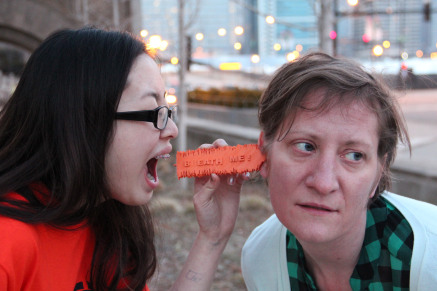
Stephanie Zhao and Jessica Hyatt photographed with Kalice’s 3-D printed sound wave from I Breathe You In.
Teen Lab at the Art Institute of Chicago is the Museum’s after-school program run in partnership with After School Matters (www.afterschoolmatters.org). Under the guidance of two teaching artists, students meet in the Ryan Education Center studios for 10 weeks, 3 days per week, to experiment with new ideas and media, meet with Museum staff and artists, hangout in the galleries, and make lots of art. Through connection with the Museum’s collection and within the context of the institution, teens investigate conceptual practices and their identities as creative producers.
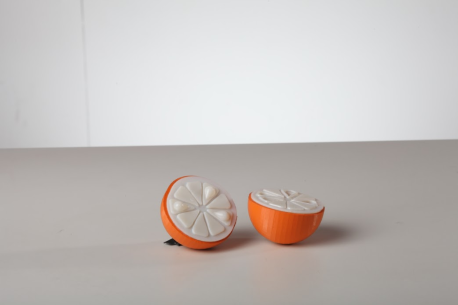
In Orange Tears, Sierrah created a meticulously designed and 3D printed orange carrying 3D printed tears.
In spring 2014, Teen Lab was give access to a 3D printer supported through the IMLS Sparks Grant. The possibility of 3D printing in the studios completely transformed how we, the instructors and the 16 teen participants, thought about the definitions and intersections between production, empowerment, value, consumerism, art, and everyday objects. What happens to value when you can produce a design in mass quantity? How do objects carry meaning? How do we represent ourselves through objects? What makes an object art and is a laborious process important? Each day brought a new exploration; from screening and discussing 3D Printing YouTube videos to scanning and printing artworks in the collection to creating self-portraits with the objects from our backpacks, our research took many forms.
Teen Lab culminated with teens creating one final project about OBJECTS, informed by our weeks of 3D research. The resulting projects were vulnerable, heartfelt, thoughtful, and all deeply immersed in the critical conversation surrounding objects in this new landscape.
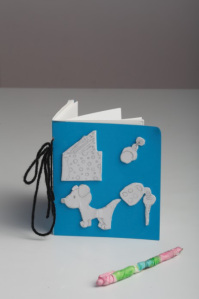
Taya designed a sculpture of a favorite pen she had lost years ago. Her work, titled Lost was displayed with a handmade notebook for viewers to write things they too had lost
Recently, I sat down with Stephanie Zhao, a teen and our former Teen Lab intern, to reflect on her experiences with Teen Lab 3D printing.
1. How is 3D printing different from 2D printing?
S: Well, the dimensions first of all. I saw more of a similarity than a difference between 3D and 2D printing. I remember in school I learned about how 2D printing revolutionized how images were reproduced and shared by the people. 3D printing gives the power of production to regular people like us, like students, and teachers, and anyone who has access to a 3D printer. It makes everyone an artisan.
2. What was the most memorable project to you and why?
S: Deshawn’s project where he tried to sculpt his head out of a stone block and then digitally rendered his head on the computer and then 3D printed it. It was a clear comparison between the old way of making objects and what 3D printing can do for everybody. It shows how far technology has come.

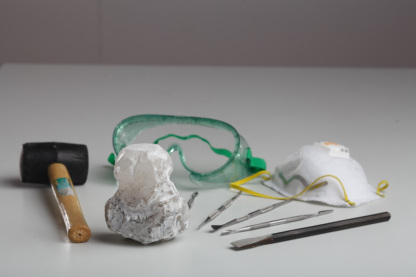 In Deshawn’s work, New vs. Old Art, he drew comparisons between traditional sculpting and 3D technologies by first scanning and 3D printing a portrait of himself and later attempting to carve a self portrait from alabaster.
In Deshawn’s work, New vs. Old Art, he drew comparisons between traditional sculpting and 3D technologies by first scanning and 3D printing a portrait of himself and later attempting to carve a self portrait from alabaster.
3. Are 3D printed models art or not?
S: I believe 3D models are to sculpture as digital graphics are to prints. Digital graphics are designs that people create on the computer, prints are designs that some people physically carve and put together. To 3d print an object, a person has to open up a program and manipulate the digital representation of an object. I don’t see that as any different than an artist taking out clay and physically manipulating it.
4. Why is it important that teens have the opportunity to experiment with 3D printing?
S: To be familiarized with the technology early on is a great experience for people. It’s important to not be afraid of new technology, but to accept what the future brings. But teenagers also have a different perspective towards technology; we grew up in a time where tech and information was being revolutionized. This 3D printer is just the next thing that’s come, it doesn’t really blow our minds the way it does for other generations. Nevertheless, 3D printing is the technology of the future, teenagers are the adults of the future. The importance of introducing us to this technology is so that we can better adapt and grow with it.
5. What do you think will be the coolest thing people will 3-D print in the future?
S: 3D printed food is something I’m looking forward to. It’s just a really novel idea.
3D printing in the medical field is something that I really think will transform the practice. I’ve heard of some places printing skin, I wouldn’t be surprised if they find a way to print organs or bones in the future.
6. Do you think differently about production after participating in this program? If so, how so?
S: With this technology I feel like I have the ability to create whatever form I can design digitally. When I was a kid, I would always make things out of play dough, and they were flimsy and delicate. They weren’t things that kids could turn into real toys. I depended on companies and stores to give me dolls and toy cars. Now you can just print these things in your home with a 3D printer. I feel like the means of production have shifted over to the public, and I’m really looking forward to seeing where it goes from here.
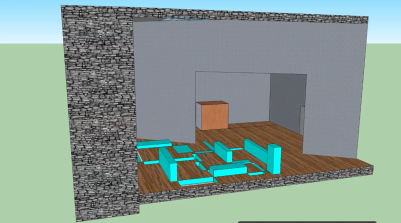
Skylar used Google Sketch-up to design Skylar’s World, based on an imaginary place she saw in her dreams.
Maura Flood is the Instructor of Teen and Studio Programs at the Art Institute of Chicago. She co-taught Teen Lab for the 2013/2014 year.
Stephanie Zhao participated in Teen Lab as an apprentice in the Fall of 2013 and as an intern in Spring 2014. She recently graduated and attends the School at the Art Institute of Chicago.

Leave a Reply